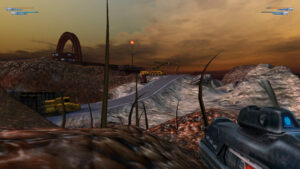Unreal II: Defense
I’ve just hit two more defense missions in a row and already I’m starting to get tired of them. I want to go exploring! I want the dopamine hit that comes from finding a new resource cache, not the sense of dread from having to carefully husband the resources you already have.
At least they’re changing up the mechanics every time. The first defense mission, the one I described before with the aliens attacking at night while you wait for a dropship to get you out of there, had space marines and some stationary devices, like turrets and force field generators, but you didn’t have control over any of them. You did your best to keep both the marines and the devices from being destroyed, because they were defending you while you defended them, but that was the extent of your interaction. The second defense mission, keeping mercenaries away while your ship undergoes repair, puts the stationary devices in your hands: it starts with a lot of tutorial dialogue explaining how to deploy force fields and so forth. The third, keeping enemies away from a captured base while one of your engineers extracts data from their computers, lets you order around a small group of marines using the game’s usual dialogue system, assigning them positions like “Defend the control room” or “Patrol the front wall”. Just on the basis of combinatorics, I’m guessing there’s going to be one more mission where you have both devices and marines at your disposal.
Come to think of it, I bet it was possible to pick up the force field generators and turrets and redeploy them elsewhere in the first defense mission. It hadn’t been explained to the player yet how to do it, but that doesn’t mean the functionality was disabled. I find that happening a lot in the mission briefings. I’ll pick up a new weapon from a fallen enemy in the course of a mission, and then between missions the tech guy back on the ship will say “I’ve been making some improvements to that weapon you found, now it has an alt-fire mode that does yadda yadda”, but I already know about that functionality, because I experimented with the alt-fire button when I first picked it up. Basically what I’m saying is that the devs didn’t bother making the mechanics fit the story completely and also the tech guy is a liar who takes credit for things he didn’t do.
 Comments(0)
Comments(0)
